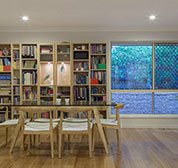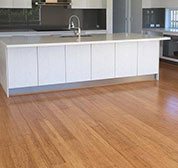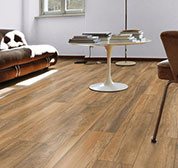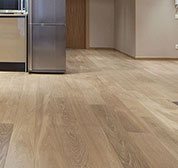Floor Care
At e-Flooring we try to give the best advice when choosing your floor, however you may not achieve a long lasting floor if you don't maintain and look after it. In this guide we will be going through the different floor types and setting out the do's and don't's but we always recommend that you check with the manufacturer as there may be variations between them. Please scroll down and take a look at the section that suits your type be it hardwood, bamboo, laminate, vinyl or even cork.
Hardwood
Hardwood floor can last a lifetime but they can suffer from damage if improperly cared for. Knowing how to clean hardwood floors is very important. Gravel and dirt is the bane of hardwood floors. Even fine dirt such as indoor plant soil can scratch and mark the floor if not removed promptly. Hardwood floor care may be more work but if someone in your household has allergies, then hardwood floors makes life much more breathable. Therefore, sweeping and dusting is a regular once a week routine, or after any event that leaves dirt and grit behind.
Do...
- Do clean sticky spots with a damp towel or sponge
- Do minimize water exposure and clean spills immediately
- Do use cleaners that won’t leave a film or residue
- Do use a professional hardwood floor cleaner to remove occasional scuffs and heel marks (just spray some cleaner on a cloth and rub the stained area lightly)
Don't
- Don’t use ammonia cleaners or oil soaps on a wood floor — they’ll dull the finish and affect your ability to recoat later.
- Don’t wet mop or use excessive water to clean your floor (wood naturally expands when it’s wet and can cause your floor to crack or splinter).
- Don’t wax a wood floor with a urethane finish
Tips
For Small Specific Areas Of Damage- Burn marks: Lightly sand the area, use a damp cloth to pick up the grit, and then refinish as desired.
- Scratches and gouges: Conceal shallow scratches with matching wood putty or a putty stick. After the area is dry, sand and refinish.
- Water marks: Remove the protective finish; rub the marks with fine grade steel wool. Repeat if necessary, clean, and then refinish.
- In most cases, when your oil and waxed hardwood floors have suffered surface damage, you have to remove the finish with a wax or oil stripper before repairing the damage. After completing the repair, you then re-wax or re-oil the area. If the damage is large, it may be best to hire a professional unless you truly understand how to repair the floors and reapply the finish.
- Following the proper care and maintenance routines and tips will keep your hardwood floors looking beautiful and enhance any room. In addition hardwood floors help reduce allergies and asthmatic problems.
Prevent & Protect Hardwood Floors
- Vacuuming is preferable to sweeping because it allows the dirt and dust to be pulled from between the boards. Use a vacuum with a bare floor attachment, not a vacuum beater bar, which can damage the wood.
- Use sheers or blinds to protect your floors from the discoloration caused by direct sun rays.
- Keep high-heeled shoes in good repair and avoid using stiletto heels or just remember to always remove shoes at the front door. Keep a pair of slippers so that you can easily walk from the front door to another room.
- Keep nails trimmed on pets.
- Use cotton area rugs and mats in high traffic areas and sites of frequent spills. Move the rugs frequently so that these areas of the floor remain the same color as the exposed floor.
- Rubber and vinyl mats and rugs trap water under them.
- Clean up spills immediately with a paper towel or dry cloth. A damp cloth can be used for sticky spills, but dry the spot immediately afterwards.
Bamboo
Bamboo floors are known for their durability. While they do put up a fight under a lot of stress, taking proper care of bamboo floors will allow them to look great even longer. How to clean bamboo floors takes very little maintenance and some forethought into preventative care.
The key to lasting beauty of your bamboo flooring investment is proper maintenance throughout the life of your floor. There are precautions and general maintenance guidelines that should be followed to maintain the beauty of your bamboo floor – this is essential bamboo flooring information for owners who want to preserve their investment. The floor should be dusted, mopped, vacuumed or swept with a soft bristle broom as necessary to remove grit and dust from the surface. Dust build-up or small pebbles can get caught under shoes and cause scratching or finish removal. Walking on a dusty or dirty floor is the quickest way to damage a finish.
Tips
- Remove dirt and dust. Dirt on the floor takes away the shine. Use a fine fiber broom or a dust mop to remove any loose dirt from the floor. Keep the floor dry to ward off areas for dust to collect. Continual traffic on a dirty floor acts like the grit on sandpaper and can put little scratches in the floors finish.
- Mop the floor. A vinegar-water mixture at a 1:4 ratio is a good cleaning agent for your floor. You may also use any hardwood floor cleaner. Use a sponge mop. Do not let the mop get too wet. Dry the floor with a towel immediately. You can harm the wood if too much water sits on the floor.
- Use a cloth to clean up spills. Fill a spray bottle with vinegar solution, and spray the area before wiping it up or you can very lightly dampen the cloth. Remember to dry the area with a towel immediately.
- Polish away any streaks. Drying the floor with a towel helps to polish the floor and remove any marks left from the dampness of the mop or cloth. Take care not to use an oil-based cleaner, which will leave your floor cloudy and streaked.
Prevent & Protect Bamboo Floors
- Avoid scratching the floor. Make sure you lift items and set them down. Put felt or coasters under furniture to keep the pieces from marring the floor when they shift. Keep pets' nails trimmed. Vacuums with a beater bar should not be used to clean the floor.
- Pay attention to shoes worn on the bamboo floor. Shoe marks can leave dirt and scuffs on the wood. Be cautious of heeled shoes. Place rugs or runners down in high-traffic areas to protect the floor from dirt build-up, scratches and scuff marks. Also place mats or rugs at each doorway to cut down on some of the dirt entering the room. Be sure to clean or shake out the rugs regularly.
- Take care of stains quickly and properly. Only use a damp cloth and appropriate cleaning solution on the floor. Scrubbing or rubbing the floor aggressively will harm the finish and the wood. Stains that are set in will need to be buffed out and the finish reapplied.
- Take steps to prevent discoloration of your bamboo floor. Hang curtains or blinds over windows to keep prolonged exposure from the sun from fading your bamboo flooring. Window tint can also be applied to windows to limit the sun's UV rays and to protect bamboo flooring.
- Buff the wood with a buff sander if the floor becomes dull to restore its luster. Do not wax the bamboo or use oil cleaners. Further information about bamboo floor care and refinishing can be received from the manufacturer of the floor.
Laminate
It's hard to damage and easy to care for laminate floors. Here are some tips on how to properly maintain them:
- Carefully read the warranty and care instructions provided for your flooring. Follow them as much as you can and refer to them if a problem develops.
- Ask for post-installation care instructions. You may not be able to mop the floor for 48 hours or you may be given other care instructions, depending on the flooring brand.
- Don't wet-mop laminate floors, because puddles could seep behind baseboards and under your floor, damaging them. Only vacuum and then damp-mop them.
- Don't ever apply wax or acrylic floor finishes.
- Use only the stain-removal products recommended by the flooring manufacturer. Typical suggestions in product literature are: acetone, for cigarette burns and nail-polish spills, and mineral spirits for grease and tar.
- Buy doormats for doorways that lead to the garage or outdoors. These doormats will trap grit that can gradually cause light scratching on the laminate floor's surface.
- Put easy-glide protective buttons on the feet of the furniture.
- Use dollies when moving a large piece of furniture or a heavy appliance across a laminate floor or else you could leave a scratch by getting tiny pebbles caught under a furniture foot or a wheel.
Take common-sense precautions to protect your floor when working with sharp or heavy objects. For example, put down a thick tarp or a carpet scrap to protect the laminate floor when installing a ceiling fan and using a drill; you can damage the floor by accidentally dropping it.
How to get the shine back on a laminate floor
- Dampen a rag in plain white vinegar and rub the floor until the shine is restored. If this restores the shine, you'll just need to clean the floor properly. If the shine has worn down due to wear, you'll have to use a laminate floor shine restoration product.
- First, sweep or vacuum the floor to be cleaned. Any particles of dirt could scratch the floor if it's ground in with a mop.
- Using a bucket of hot water, add 3/4 to 1 cup of vinegar, depending on the size of the floor.
- Dip the mop into the water and vinegar mixture, wring as tightly as possible so that the mop is damp, not dripping wet.
- Rinse the mop often in the water/vinegar to remove any residue from the floor.
Tips
- If there's a heavy haze on the floor, you may need to repeat the above a few times to restore the shine.
- You should never use an all-purpose cleaner (the type used to clean vinyl or ceramic floors) on laminate floors. Unless the floor is really dirty, most of the time you'll just need to sweep/vacuum and mop with plain hot water.
- If you see any spots/stains on the floor, simply wipe them up with a damp cloth/paper towel. If the stain is oily/greasy, dampen the cloth with vinegar to remove the oily stain.
Vinyl
Vinyl flooring is a beautiful, long lasting and durable product that can withstand many years of use... and abuse. But vinyl flooring is not invulnerable and can be permanently damaged if you don't care for it properly.Do...
- Wipe up spills as soon as possible.
- Wash your floor occasionally with an appropriate no-rinse floor cleaner.
- Some heavier duty floor cleaners may be able for the more resistant dirt or stains.
- Use a vinyl floor polish to return your floor's original shine if it begins to dull over time.
- Do not use detergents, abrasive cleaners or "mop and shine" products - they may leave a dull film on your floor.
- Do not use paste wax or solvent-based polishes.
- Do not use a beater bar when vacuuming because it can visibly damage the floor surface.
- Do not use highly abrasive scrubbing tools.
Preemptive Protection For Your Floor...
Prevent possible damage to your new floor by following these suggestions...
When moving appliances or heavy furniture, lay a plywood or hardboard panel on your floor and "walk" the item across it. This protects your floor from scuffing and tears.
Use floor protectors on furniture to reduce indentation. As a general rule of thumb, the heavier the item, the wider the floor protector needed. Be especially careful with furniture with metal protectors... these can both cause deep indentations and rust stains!
Be careful with rolling casters! They can damage the floor. Therefore, we do not recommend them. If you choose to use them, the double-wheel type are the best option. Place a walk-off mat at outside entrances to reduce the amount of dirt brought into your home. We do not recommend the use of rubber or latex-backed mats because the chemical (antioxidant) used to keep the backing from becoming brittle can permanently stain your floor. This is called "antioxidant staining". We suggest a non-staining vinyl-backed mat or a woven rug that is colorfast. Most of these products are identified "colorfast" by the manufacturer. All Armstrong floor care products have been specifically developed to care for Armstrong floors. You may purchase Armstrong floor care products at your local flooring retailer.
Immediately After Installation...
For 8 hours after seam application, protect the sealed seams on your flooring. This will ensure the proper seam bond. If your seams are disturbed before they're dry, permanent damage may result.Maintain room temperature at 65 degrees Fahrenheit for 48 hours after installation is completed. This assures proper curing, setting and bonding of products.
Use a damp sponge, cloth, or mop to wipe off the Armstrong logo and "800" number printed on the face of the floor. To avoid staining, be careful not to wipe across any seams!
The adhesive under your floor needs time to thoroughly dry after installation. Therefore we recommend that you do not scrub or wash your floor for five days.
Stain removal tips for specific problems...
Vinyl flooring, though quite durable, is not immune to staining. Many types of stains are removable, but some may not be! So, first and foremost... be careful when using staining products around your floor. If spills occur, quick removal can make all the difference in protecting your floor.
Cork
Cork flooring, available in a variety of interesting colors and textures, has a rich, earthy appearance. When it comes to maintenance, cork flooring is easily kept in clean, tip-top shape, much the same way as tile or wood. As an added benefit, it is an environmentally-friendly flooring, as cork is a renewable, natural material. A small time investment spent cleaning and caring for your cork floor will pay off with many years of enjoyment.
To help your cork floor keep its “just installed” look, try these preventive maintenance suggestions:
- Place breathable mats in front of sinks and in doorways
- Note: do not use mats with rubber or other non-porous backings since these could trap moisture and affect the finish
- Put felt pads under furniture legs to prevent scuffs
- When moving furniture; lift it, don’t drag it
- Place a drip pan under potted plants to catch water seepage
- Prevent fading from excessive sunlight with window treatments, like curtains, drapes, blinds, or with window tint
Tips
When it comes to cleaning, cork flooring requires no special equipment or harsh chemicals. The basic steps are as follows:- Wipe up spills immediately
- Note: cork is a wood product and therefore will absorb moisture
- To reduce scratches, sweep or vacuum regularly to remove abrasive debris
- To clean a heavier soiled area, use only a cleaner formulated for pre-finished hardwood floors













